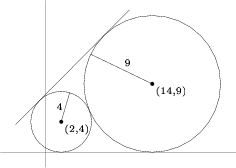Difference between revisions of "2006 AMC 12A Problems/Problem 19"
Armalite46 (talk | contribs) m (→Solutions) |
Mathgeek2006 (talk | contribs) m (→Problem) |
||
| Line 3: | Line 3: | ||
<center>[[Image:AMC12_2006A_19.png]]</center> | <center>[[Image:AMC12_2006A_19.png]]</center> | ||
| − | <math> \mathrm{(A) \ } \frac{908}{ | + | <math> \mathrm{(A) \ } \frac{908}{119}\qquad \mathrm{(B) \ } \frac{909}{119}\qquad \mathrm{(C) \ } \frac{130}{17}\qquad \mathrm{(D) \ } \frac{911}{119}\qquad \mathrm{(E) \ } \frac{912}{119}</math> |
== Solution == | == Solution == | ||
Revision as of 15:51, 28 September 2014
Problem
Circles with centers ![]() and
and ![]() have radii
have radii ![]() and
and ![]() , respectively. The equation of a common external tangent to the circles can be written in the form
, respectively. The equation of a common external tangent to the circles can be written in the form ![]() with
with ![]() . What is
. What is ![]() ?
?

![]()
Solution
Let ![]() be the line that goes through
be the line that goes through ![]() and
and ![]() , and let
, and let ![]() be the line
be the line ![]() . If we let
. If we let ![]() be the measure of the acute angle formed by
be the measure of the acute angle formed by ![]() and the x-axis, then
and the x-axis, then ![]() .
. ![]() clearly bisects the angle formed by
clearly bisects the angle formed by ![]() and the x-axis, so
and the x-axis, so ![]() . We also know that
. We also know that ![]() and
and ![]() intersect at a point on the x-axis. The equation of
intersect at a point on the x-axis. The equation of ![]() is
is ![]() , so the coordinate of this point is
, so the coordinate of this point is ![]() . Hence the equation of
. Hence the equation of ![]() is
is ![]() , so
, so ![]() , and our answer choice is
, and our answer choice is ![]() .
.
See also
| 2006 AMC 12A (Problems • Answer Key • Resources) | |
| Preceded by Problem 18 |
Followed by Problem 20 |
| 1 • 2 • 3 • 4 • 5 • 6 • 7 • 8 • 9 • 10 • 11 • 12 • 13 • 14 • 15 • 16 • 17 • 18 • 19 • 20 • 21 • 22 • 23 • 24 • 25 | |
| All AMC 12 Problems and Solutions | |
The problems on this page are copyrighted by the Mathematical Association of America's American Mathematics Competitions. 









